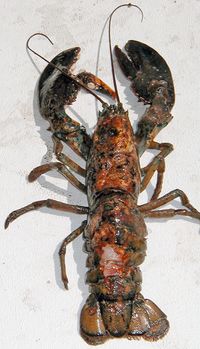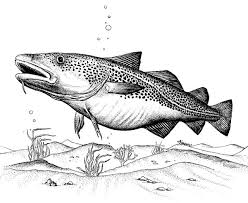Evolution in the Gulf of Maine: Difference between revisions
| Line 19: | Line 19: | ||
<br> | <br> | ||
==Current Research== | ==Current Research== | ||
<i>Gadus morhua</i> and it's gut microbiome is affected by more than just climate change and fishing in the wild. Current research by Bagi et al.<ref>[https://bmcmicrobiol.biomedcentral.com/articles/10.1186/s12866-018-1171-2 Bagi et al., “Gastrointestinal microbial community changes in Atlantic cod (Gadus morhua) exposed to crude oil”. 2018. BMC Microbiology 18:25.]</ref> have shown the negative impacts of crude oil spills. After starving <i>Gadus morhua</i> specimen for 7 days, Bagi et al. introduced varying levels of petroleum oil into their environment (between 0 and 0.1 mg/L) and measured the genome of the specimens’ microbiomes after 28 days of exposure. They found that exposure to medium or high concentrations of petroleum oil (0.05 mg/L to >0.1 mg/L) caused the population of microbial organisms in the gut microbiome of <i>Gadus morhua</i> to decrease, except in the case of <i>Deferribacteres</i>. <i>Deferribacteres</i> comes from an acetoclastic iron-reducing phylum, and previous studies have shown exposure to oil results in a decrease in iron-binding by the host organism making the mineral even more available to the microbe. While <i>Deferribacteres</i> had a higher concentration, the concentration of <i>Fusobacteriales</i>, <i>Clostridiales</i> and <i>Alteromonadales</i> significantly decreased in medium and high exposure samples. The oil contained all of the EPA’s polycyclic aromatic hydrocarbons (PAHs), which are confirmed carcinogens that the liver and gut microbes can transform into conjugated metabolites (a process that makes them even more harmful). If more of this pollution continues, it is likely the diversity of microbes in the gut of <i>Gadus morhua</i> will decrease, which has the potential to limit its fitness. Even though oil drilling is not common in the region, and lobstermen as well as environmentalists | <i>Gadus morhua</i> and it's gut microbiome is affected by more than just climate change and fishing in the wild. Current research by Bagi et al.<ref>[https://bmcmicrobiol.biomedcentral.com/articles/10.1186/s12866-018-1171-2 Bagi et al., “Gastrointestinal microbial community changes in Atlantic cod (Gadus morhua) exposed to crude oil”. 2018. BMC Microbiology 18:25.]</ref> have shown the negative impacts of crude oil spills. After starving <i>Gadus morhua</i> specimen for 7 days, Bagi et al. introduced varying levels of petroleum oil into their environment (between 0 and 0.1 mg/L) and measured the genome of the specimens’ microbiomes after 28 days of exposure. They found that exposure to medium or high concentrations of petroleum oil (0.05 mg/L to >0.1 mg/L) caused the population of microbial organisms in the gut microbiome of <i>Gadus morhua</i> to decrease, except in the case of <i>Deferribacteres</i>. <i>Deferribacteres</i> comes from an acetoclastic iron-reducing phylum, and previous studies have shown exposure to oil results in a decrease in iron-binding by the host organism making the mineral even more available to the microbe. While <i>Deferribacteres</i> had a higher concentration, the concentration of <i>Fusobacteriales</i>, <i>Clostridiales</i> and <i>Alteromonadales</i> significantly decreased in medium and high exposure samples. The oil contained all of the EPA’s polycyclic aromatic hydrocarbons (PAHs), which are confirmed carcinogens that the liver and gut microbes can transform into conjugated metabolites (a process that makes them even more harmful). If more of this pollution continues, it is likely the diversity of microbes in the gut of <i>Gadus morhua</i> will decrease, which has the potential to limit its fitness. Even though oil drilling is not common in the region, and lobstermen as well as environmentalists indicate that climate change isn’t the only force threatening the health of this species in the Gulf of Maine. | ||
<br> | <br> | ||
Latest revision as of 04:41, 7 December 2019
Introduction

The Gulf of Maine is a region of the Atlantic Ocean surrounded by the New England states of the US and Nova Scotia of Canada. The evolution of its marine life has been the result of millions of years of glacial and tectonic plate movements and the introduction and extinction of species, fishing industries, and climate change. While most of its microbiome establishes and maintains health in the ecosystem, a few pesky microbial organisms have wreaked havoc to parts of the Gulf and the local fishing industries. Given that scientists estimate 3,200 species live in this large ecosystem, it is simpler to focus on a few key organisms to develop an overview of the evolution of the Gulf of Maine.
Evolution

Atlantic Lobster
The Atlantic lobster, Homarus americanus, has been a vital organism for the ecosystem and economy of the Gulf of Maine. Data from fossils suggests lobsters have been present since the Cretaceous period, and became more diverse during the Tertiary period [1]. That diversity increased again later. Recent fluctuations in the populations of H. americanus have been predominantly affected by climate change and the fishing industry. Measured tempuratures in the Gulf of Maine at the sea surface have significantly increased in recent years from global warming. While it is currently causing an increase in the population of Atlantic lobsters, any further warming will have adverse effects on the species [2]. One of the potential threats is epizootic shell disease, which causes shell erosion and appears more prevalently in northern regions compared to the south[3]. The lobster fishing industry has been heavily regulated like the requirement of a minimum length from the eye socket to the beginning of the tail of 3.25 inches to allow a little less than 50% of lobsters to reproduce before being caught[4]. Nevertheless, these regulations cannot compensate for the large percentage of lobsters that are taken from their habitat, which has led to a historical decrease in the abundance of lobsters in the Gulf of Maine.
Atlantic Cod

The Atlantic cod, Gadus morhua, is native to the Gulf of Maine and one of the main predators in the ecosystem. Its role in the food web came as a result of geologic events, like the opening of the Arctic passage, the creation of the Panama Isthmus, and the creation of continental shelves around the newly formed Iceland. The opening of the Arctic passage increased the biological diversity of the Atlantic Ocean providing a greater availability and diversity of food sources for the cod. The Panama Isthmus caused west-ward flowing currents to shift and move up north, creating new habitats for the cod to proliferate in thanks in part to the warm waters the currents carried. The continental shelves of Iceland created even more habitat for the cod to adapt to and grow within explaining its abundance throughout the northern Atlantic Ocean[5]. The Atlantic cod already has a vulnerable (threatened) status due to human consumption and overfishing, and climate change only adds salt to the wound. The waters in the Gulf of Maine have become too warm for cod, even after fishing was reduced, because the Gulf has warmed the most compared to other bodies of water around the world and the cod is particularly sensitive to warmer temperatures[6].
Microbiome

A survey by the Census of Marine Life shows there are an estimated 3,200 species residing in the Gulf of Maine from which 733 are microscopic organisms like algae, bacteria, protists, and archaea[7]. Of the planktonic microorganisms, one species has caused significant damage since the turn of the century: Alexandrium fundyense. It is a toxic dinoflagellate that causes paralytic shellfish poisoning during a red tide (algal bloom) because it creates saxitoxin, a neurotoxin[8]. Research has been growing since the early 2000’s on A. fundyense because it has recently affected the shell-fishing industry due to saxitoxin’s harmful effects on humans. The life cycle of the dinoflagellate involves a dormant period as a cyst on the surface of the ocean floor during winter, and scientists predict that climate change could increase the period of time the dinoflagellate remains active or increase the intensity of blooms through more frequent and harsher hurricanes, which would mix more nutrients into the water from the ocean floor.
Current Research
Gadus morhua and it's gut microbiome is affected by more than just climate change and fishing in the wild. Current research by Bagi et al.[9] have shown the negative impacts of crude oil spills. After starving Gadus morhua specimen for 7 days, Bagi et al. introduced varying levels of petroleum oil into their environment (between 0 and 0.1 mg/L) and measured the genome of the specimens’ microbiomes after 28 days of exposure. They found that exposure to medium or high concentrations of petroleum oil (0.05 mg/L to >0.1 mg/L) caused the population of microbial organisms in the gut microbiome of Gadus morhua to decrease, except in the case of Deferribacteres. Deferribacteres comes from an acetoclastic iron-reducing phylum, and previous studies have shown exposure to oil results in a decrease in iron-binding by the host organism making the mineral even more available to the microbe. While Deferribacteres had a higher concentration, the concentration of Fusobacteriales, Clostridiales and Alteromonadales significantly decreased in medium and high exposure samples. The oil contained all of the EPA’s polycyclic aromatic hydrocarbons (PAHs), which are confirmed carcinogens that the liver and gut microbes can transform into conjugated metabolites (a process that makes them even more harmful). If more of this pollution continues, it is likely the diversity of microbes in the gut of Gadus morhua will decrease, which has the potential to limit its fitness. Even though oil drilling is not common in the region, and lobstermen as well as environmentalists indicate that climate change isn’t the only force threatening the health of this species in the Gulf of Maine.
Conclusion
The American lobster and Atlantic cod have been 2 large populations present in the Gulf of Maine for millions of years and lend their success to the geologic history and the bioavailability of food. The intense change in the abundance of some of the Gulf of Maine's key organisms show how a few simple changes can alter the entire balance. The future evolution of the Gulf relies on how intense climate change's effects will be and how detrimental human practices like fishing and dumping of harmful human-made products remain.
References
- ↑ Tschudy, Dale, " Clawed Lobster (Nephropidae) Diversity through Time." 2003. Journal of Crustacean Biology 23:178-186.
- ↑ Greene, Charles, "North America's Iconic Marine Species at Risk Due to Unprecedented Global Warming." 2016. Oceanography 29:14-17
- ↑ Glenn, Robert, "Epizootic Shell Disease in American Lobster in Massachusetts Coastal Waters: Interactions of Temperature, Maturity and Intermolt Duration". 2006. Journal of Crustacean Biology 4:639-645.
- ↑ "Lobster History". 2012. Gulf of Maine Research Institute.
- ↑ Marteinsdottir, Guorun and Rose, George, "Atlantic Cod: Origin and Evolution". 2019. John Wiley and Sons, Ltd.
- ↑ Reuters "Water Too Warm for Cod in U.S. Gulf of Maine, Stock Near Collapse" 2015. NBC News.
- ↑ http://www.coml.org/discoveries/ecology/gulf_of_maine_biodiversity.html
- ↑ Stuken et al. “Discovery of Nuclear-Encoded Genes for the Neurotoxin Saxitoxin in Dinoflagellates”. 2011. PLoS ONE 6:e20096.
- ↑ Bagi et al., “Gastrointestinal microbial community changes in Atlantic cod (Gadus morhua) exposed to crude oil”. 2018. BMC Microbiology 18:25.
Edited by [Madi Hamilton], student of Joan Slonczewski for BIOL 116 Information in Living Systems, 2019, Kenyon College.
